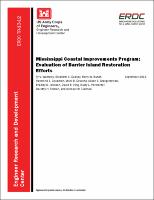Please use this identifier to cite or link to this item:
https://hdl.handle.net/11681/8501| Title: | Mississippi Coastal Improvements Program ; evaluation of barrier island restoration efforts |
| Authors: | Mississippi Coastal Improvements Program (U.S.) United States. Army. Corps of Engineers. Mobile District United States. Army. Corps of Engineers. Jacksonville District Environmental Laboratory (U.S.) Wamsley, Ty V. Godsey, Elizabeth S. Bunch, Barry W. Chapman, Raymond S. Gravens, Mark B. Grzegorzewski, Alison S. Johnson, Bradley D. King, David B. (David Byron) Permenter, Rusty L. Hamlin-Tillman, Dorothy E. Tubman, Michael W. (Michael Wright), 1951- |
| Keywords: | Borrow areas Breach Coastal Morphology Hurricane Water quality Mississippi Sound Shoreline erosion Storm waves Mississippi barrier islands Gulf Coast Gulf of Mexico |
| Publisher: | Coastal and Hydraulics Laboratory (U.S.) Engineer Research and Development Center (U.S.) |
| Series/Report no.: | ERDC TR ; 13-12. |
| Description: | Technical Report Abstract: A comprehensive numerical modeling study was undertaken to support the barrier island restoration plan as part of the Mississippi Coastal Improvements Program. Hydrodynamic, wave, sediment transport, and water quality numerical modeling was conducted to evaluate the effect of Camille Cut closure on circulation and water quality of Mississippi Sound; the combined effect of Camille Cut and Katrina Cut closures on circulation and water quality of Mississippi Sound; reduction of storm wave energy at the mainland Mississippi coast as a result of closing Camille Cut; and optimization of nearshore placement of sand in the littoral zone. Water quality modeling of Mississippi Sound was conducted to determine potential impacts from proposed actions in the Ship Island area using the Curvilinear Hydrodynamic 3D model (CH3D) and the water quality model (CE-QUAL-ICM). Although water quality changes were observed for the alternatives modeled, the impact of Ship Island degradation or restoration does not significantly alter system wide circulation and water quality conditions. However, the condition of Ship Island has localized effects on circulation and water quality. The changes in storm wave energy at the mainland Mississippi coast as a result of Ship Island degradation and restoration were quantified through the application of an integrated coastal storm modeling system. Results indicate that the closure of Camille Cut and Ship Island restoration have the potential to reduce storm waves at the mainland coast. The C2SHORE model was applied to numerically predict the morphological response and sand fate for a selection of proposed alternatives. Results indicate that the Camille Cut restoration fill survives higher-frequency storms (such as the 1-yr and 10-yr events), but is breached during the lower-frequency 500-yr event modeled. Potential impacts of nearshore borrow areas were assessed with the spectral nearshore wave transformation model STWAVE and shoreline change model GENESIS. Scenarios included borrow areas offshore of Ship Island, Horn Island, and West Dauphin Island and were evaluated over a period of 20-years. The expected shoreline impacts are site-specific, with both prograding and eroding shoreline areas predicted. NOTE: This file is very, very large. Please allow your browser several minutes to download the file. |
| Rights: | Approved for public release; distribution is unlimited. |
| URI: | http://hdl.handle.net/11681/8501 |
| Appears in Collections: | Technical Report |
Files in This Item:
| File | Description | Size | Format | |
|---|---|---|---|---|
| ERDC-TR-13-12.pdf | 92.03 MB | Adobe PDF |  View/Open |